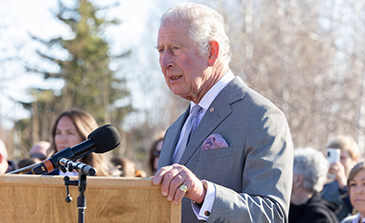The Monarch

The King, then Prince of Wales, gives a speech at the Ceremonial Circle in Yellowknife, Northwest Territories on May 19, 2022.
Canada is a constitutional monarchy. Since 1534, when the King of France claimed possession of what is now Canada, the history of our country has been marked by the reigns of an uninterrupted succession of monarchs, both French and British, who have had a significant influence on our country's development.
Queen Elizabeth II was the first of Canada's sovereigns to be proclaimed separately as Queen of Canada in 1953, when a Canadian law, the Royal Style and Titles Act, formally conferred upon her the title of "Queen of Canada". The proclamation reaffirmed the monarch’s role in Canada as independent of the monarch’s role in the United Kingdom and other Commonwealth realms.
As a constitutional monarch, His Majesty King Charles III doesn't "rule" the country. However, as Canada's Head of State, he remains a fundamental part of Canada's system of government and our sense of identity.
The King's Role
As the personal embodiment of the Crown, His Majesty's role is to unite Canadians and give a collective sense of belonging to our country.
In his declaration to the Accession Council on September 10, 2022, His Majesty King Charles III stated:
I am deeply aware of this great inheritance and of the duties and heavy responsibilities of sovereignty which have now passed to me. In taking up these responsibilities, I shall strive to follow the inspiring example I have been set in upholding constitutional government and to seek the peace, harmony and prosperity of the peoples of […] the Commonwealth Realms and Territories throughout the world.
New Canadians swear allegiance to The King, so as Members of Parliament and the Legislatures, military and police officers.
We do not swear allegiance to a document (a constitution) or a political entity. Rather we swear allegiance to a person who embodies all these as well as our collective values.